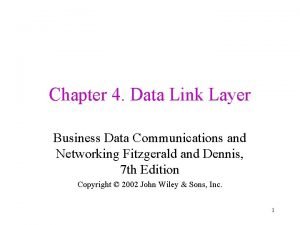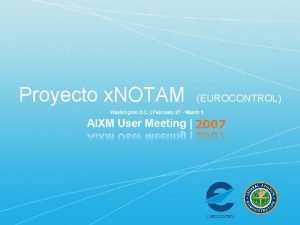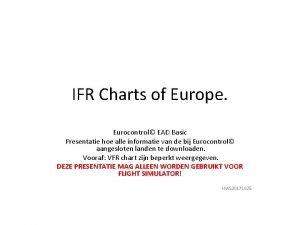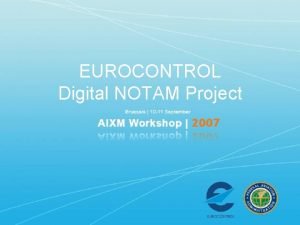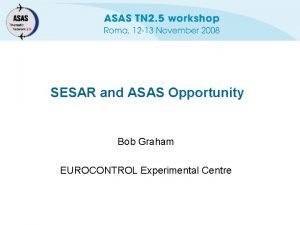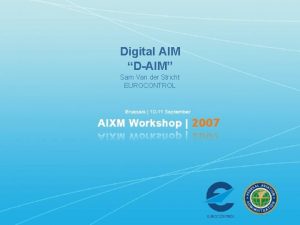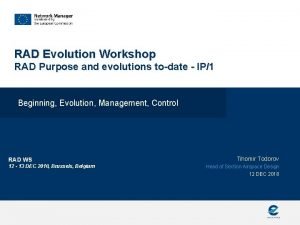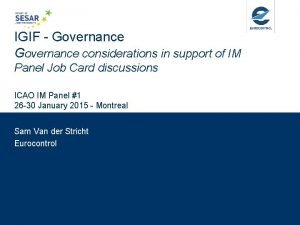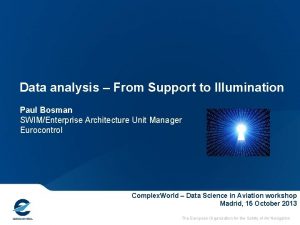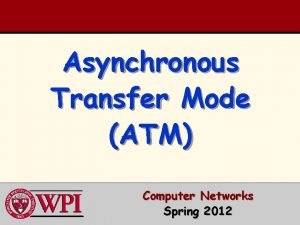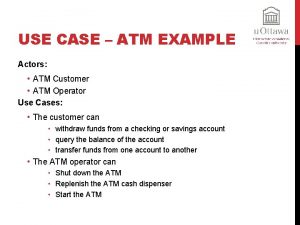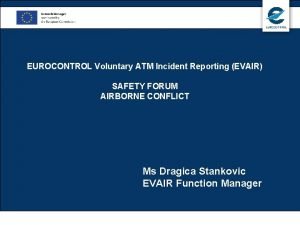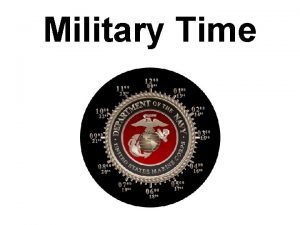Military Data Links and ATM EUROCONTROL Military Unit
















- Slides: 16

“Military Data Links and ATM” EUROCONTROL Military Unit European Organisation for the Safety of Air Navigation

Summary ♦ CONTEXT ♦ DESCRIPTION / OBJECTIVES of military data links and operational expectations ♦ CHALLENGES : Interoperability/ Safety/Security / Technology ♦ CONCLUSION 2

Introduction Traffic Growth 1997 7. 0 million flights 2000 8. 0 million flights u 2010 11. 1 million flights 2020 16. 0 million flights Traffic Growth: - 10 JUN 05: Record of 30. 047 flights; - Growth of 5% a year; - Traffic doubles over 20 years; - Traffic tripled over 25 years. 3 DIVISION DED 4 - 4/11/97

Introduction Operational Improvements TRAFFIC GROWTH INCREASE CAPACITY OERATIONAL IMPROVEMENTS IMPROVE SAFETY 4

Introduction Multiple Airspace Users ATM Operational Improvements impact all airspace users including Military Aviation! 5

DESCRIPTION / OBJECTIVES of the military data links ♦ Command Control Information Exchange ♦ NATO Tactical Data Links and the migration strategy ♦ The military data links 6

Military Command Control Tactical Information Exchange u Military CIS are enablers of Command Control (C 2) functions; u Underlying Networks (WANs) + Voice + Sensors + Tactical Data Links for C 2 reporting and compilation of Recognized Air Picture 7

Tactical Data Links Migration Strategy Migration Path ♦ Each Data Link defined by message format series ♦ Link 1, Link 4 and Link 7 were the legacy standards ♦ Link 11 – since early 80’s the most stable NATO standard. Oriented to Navy and BLOS ♦ Link 16 – Current NATO MOR and in vast expansion since mid 90’s. Supported by JTIDS/MIDS technology ♦ Link 22/NILE – NATO Improved Link 11 – 2015 ♦ Multilink environment: VMF, TTNT, CDL, Wideband IP D/L ♦ Future Paradigm: The Common Message Standard (CMS) - 2030 8

Military Multi-Link Environment Automating multiple platforms VMF – Variable Message Format (gap filler for US Army between Link 16 and other TDL) CDL – Common Data Link ( US Do. D D/L to support imagery and signals intelligence) TTNT - Tactical Targeting Network Technology (US DARPA IP-capable airborne network for primarily time-sensitive targeting which will support US Do. D Global Information Grid) 9

Challenges ♦ Civil/Military Interoperability ♦ADS-B/MIDS Study ♦ Safety and Security considerations ♦ Technology enablers 10

INTEROPERBILITY ADS-B/MIDS Study “FEASIBILITY STUDY FOR CIVIL AVIATION DATA LINK FOR ADS-B BASED ON MIDS/LINK 16” Background ADS Programme Ø 17 -18 SET 02 - ADS PSG 15 decision to study feasibility of civil version of Link 16/MIDS to support ADS-B Ø FEB 03 - ADS-B Data Link Recommendation Ø FEB 03 - ISDEFE contracted Ø AUG 03 - Final Report delivered Ø 10 MAR 04 – Discussion Forum Proposal Ø Ø Ø Compare ADS Requirements vs MIDS Performances Scenarios: TLAT Prove Feasibility Significant benefits for civil ATM and military But difficult open issues: - Network management; Spectrum support; Interference DME/TACAN, GPS L 5; Costs; Institutional issues. 11

INTEROPERABILTY ADS-B/MIDS Study “FEASIBILITY STUDY FOR CIVIL AVIATION DATA LINK FOR ADS-B BASED ON MIDS/LINK 16” Discussion Forum on 10 MAR 04 Ø Ø Ø ADS-B/MIDS study considered solution feasible Majority of opinions against the proposal Reasons mainly linked with spectrum constraints in the L band institutional issues Way Ahead Ground Interface solution ? Part of Software Radio solution ? ü A civil-military Future Communications System! 12

Safety and Security considerations ♦ Safety ♦ Traffic growth vs. military aircraft Equipage rate ♦ Exemption policy ♦ Security considerations ♦ 9/11 context and its consequences ♦ The need to protect the ATM system and the need for more civil/military cooperation 13

Technology considerations ♦ Software radio considerations ♦ Civil /military aspects ♦ Taking advantage of some military data link features ♦ Convergence between C, N, S ♦ Security 14

Military Data Links and ATM Conclusions (1) ♦ Military Data Link technologies are in the forefront of state of the art ♦ Widely available in military platforms (particularly Link 16/MIDS) ♦ Outstanding warfare capablilities enabled by multi-link environment ♦ Limited relevance for ATM purposes ♦ Civil-military data link interoperability uncertain ♦ Frequency and spectrum constraints the main problem ♦ Other hurdles are institutional, security and technical constraints (latency, Doppler, etc. ) ♦ Lessons learnt from ADS-B/MIDS study need to be kept ♦ Trend for convergence: use of Internet Protocol (IP Mobility) ♦ Additional opportunities: Relative Navigation 15

Military Data Links and ATM Conclusions (2) Navigation Paradigm: GNSS Sole Means? Ground-Based DME Backup? 4 D RNP/RNAV how? Why not Relative Navigation as an enabler of NAV infrastructure rationalisation? 16
 Business data links
Business data links Notams eurocontrol
Notams eurocontrol Ead basic
Ead basic Eurocontrol
Eurocontrol Notam eurocontrol
Notam eurocontrol Eurocontrol one sky
Eurocontrol one sky Eurocontrol experimental centre
Eurocontrol experimental centre Eurocontrol sam
Eurocontrol sam Eurocontrol rad
Eurocontrol rad Eurocontrol
Eurocontrol Free route airspace czech republic
Free route airspace czech republic Swimea
Swimea Paul bosman eurocontrol
Paul bosman eurocontrol Atm in data communication
Atm in data communication Joint and link
Joint and link Formal and contextual links in discourse
Formal and contextual links in discourse Example of tanaga poem
Example of tanaga poem
